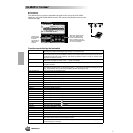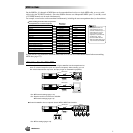
MIDI Functions
168 Reference
MIDI Functions
Built into the rear panel of the 9000Pro are two standard sets to MIDI terminals (MIDI IN A/B, MIDI OUT
A/B), a TO HOST terminal, and a HOST SELECT switch. The MIDI Functions give you a comprehensive,
powerful set of tools for expanding your music recording and performance possibilities.
This section explains what MIDI is, and what it can do, as well as how you can use MIDI on your 9000Pro.
No doubt you have heard the terms “acoustic instrument” and “digital instrument.” In the world
today, these are the two main categories of instruments. Let’s consider an acoustic piano and a clas-
sical guitar as representative acoustic instruments. They are easy to understand. With the piano, you
strike a key, and a hammer inside hits some strings and plays a note. With the guitar, you directly
pluck a string and the note sounds. But how does a digital instrument go about playing a note?
As shown in the illustration above, in an electronic instrument the sampling note (previously
recorded note) stored in the tone generator section (electronic circuit) is played based on informa-
tion received from the keyboard. So then what is the information from the keyboard that becomes
the basis for note production?
For example, let’s say you play a “C” quarter note using the grand piano sound on the 9000Pro key-
board.
Unlike an acoustic instrument that puts out a resonated note, the electronic instrument puts out
information from the keyboard such as “with what voice,” “with which key,” “about how strong,”
“when was it pressed” and “when was it released.” Then each piece of information is changed into a
number value and sent to the tone generator.
Using these numbers as a basis, the tone generator plays the stored sampling note.
MIDI is an acronym that stands for Musical Instrument Digital Interface, which allows electronic
musical instruments to communicate with each other, by sending and receiving compatible Note,
Control Change, Program Change and various other types of MIDI data, or messages.
The 9000Pro can control a MIDI device by transmitting note related data and various types of con-
troller data. The 9000Pro can be controlled by the incoming MIDI messages which automatically
determine tone generator mode, select MIDI channels, voices and effects, change parameter values
and of course play the voices specified for the various parts.
MIDI messages can be divided into two groups: Channel messages and System messages. Below is an
explanation of the various types of MIDI messages which the 9000Pro can receive/transmit.
What’s MIDI?
● Acoustic guitar note production ● Digital instrument note production
Pluck a string and the body
resonates the sound.
Based on playing information from the keyboard, a
sampling note stored in the tone generator is played
through the speakers.
Sampling Note Sampling Note
Tone Generator
(Electric circuit)
Playing the keyboard
RL
● Example of Keyboard Information
Voice number (with what voice) 01 (grand piano)
Note number (with which key) 60 (C3)
Note on (when was it pressed) and
note off (when was it released)
Timing expressed numerically (quarter note)
Velocity (about how strong) 120 (strong)
166


















